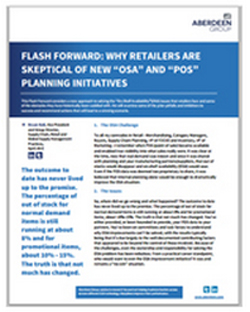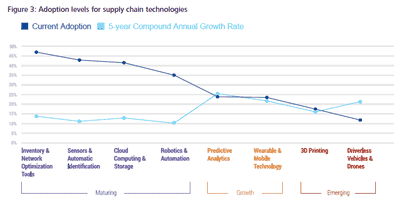 |
June 4, 2015 - Supply Chain Flagship Newsletter |
 |
| FEATURED SPONSOR: JDA |
||
 |
||
Download the White Paper: Flash Forward – Why Retailers are Skeptical of New 'OSA' and 'POS' Planning Initiatives |
 |
|
||||||||||||||||||||||||||||||||||||||||||||||||||||||||||||||||||||||||||||||||||||||||||||||||
One quick note is that membership in MHI is at a company level, not an individual level such as CSCMP, ISM, or WERC. That's why in some quarters it is not well known. Some of that legacy core materials handling orientation is still around, but now it's just known as MHI, with the relatively new tag line of "the industry that makes supply chains work." And that full supply chain orientation is increasingly on display, whether it's the positioning of the now twice held MODEX trade show in Atlanta (the off-year show to MHI's bi-annual ProMat show in Chicago), its rapidly evolving annual conference, and the large amount of work MHI did in 2014 to develop what it called the "U.S. Roadmap for Material Handling & Logistics." (Note: I was a modest participant in that process.) Similar changes for MHI's "annual report" for 2015. In the past, this was a document that mostly summed up spending cycles for materials handling equipment and what types of equipment and systems were seeing what share of the money companies were spending. That annual report structure was totally changed for 2015, released in March to coincide with ProMat. Prepared in partnership with consulting firm Deloitte, this document basically flows as an add-on to the 2014 Roadmap, and is focused on broad trends and issues in the supply chain. In other words, to use a cliché, this is not your father's MHI. I will offer more thoughts on this MHI evolution and what it might mean for practitioners and other industry organizations such as CSCMP later this summer. For the here and now, below is a quick summary of the report, some of which is based upon survey data from supply chain managers. The report looks into eight of what it calls game-changing technologies first identified in the Roadmap report. That list is populated with the usual suspects, but offers some nice perspectives on each nevertheless. Those eight technologies are as follows:
• Inventory and network optimization tools My only quibbles would be that: (1) "inventory and network optimization tools" is too broad a category; (2) it's not just "predictive" analytics; and (3) "driverless vehicles and drones" are two very different things - one could thrive, the other tank. That said, I liked the chart below, which takes each of these eight technologies and plots its current level of penetration in companies (adoption rate) versus a projected average annual growth rate in sales dollars over the next five years.
So, logically enough, a category such as inventory and network optimization tools that has high current penetration rates (about 48%) has a relatively modest predicted five-year average growth rate (15%). Predictive analytics, by contrast, has a lower level of current penetration (about 25%) but is growing at about that same rate (and is in fact the fastest growing of all eight technologies). The end user survey also found that 35% of respondents consider their companies "early adopters" of technology, while another 19% say they are "opportunistic" adopters (defined as "adopting new technologies when the advantages are clear"), with 46% saying they are generally "forced adopters," meaning they will move forward only when compelled to do so by mandate, regulation, or competitive necessity. My own observation is that the early adopter percentage reported here is a high, a perspective I think supported by other surveys, such as the one SCDigest does annually with Gartner, which has found "aggressive" supply chain technology adopters represent only about 12% of all companies versus 46% saying they are "mainstream" and 42% "conservative." But the definitions aren't exactly the same across the three categories in the two surveys, so who knows. My original intention was to summarize the report's take on each of these eight technologies, but the way it plays out that is very hard to do, so I am taking an easier way out and just looking at the recommendations in one technology area, "inventory and network optimization tools." Here is what the report states supply chain leaders should be doing in this area, with my brief commentary on each point: Align your network with your customers' strategies: The report emphasizes the need to first understand customers' needs and plans, and then segment customers based not only on their value to you, but also on how they value your products and services. For example: Do they prefer low prices over lead time responsiveness, or vice versa? The answers to such questions will of course impact how you design your network. My response: Ok, but key really is figuring out how to largely use the same basic physical network to provide differentiated service across segments based on their value drivers, which today's technology allows you to do. And don't forget the supply side of the network design. Understand your costs: Report says some companies spend considerable time and money painstakingly modeling their supply chain network only to base decisions on fundamentally flawed cost data. Making significant network decisions should use activity-based costing for major cost drivers. Most companies accurately calculate variable costs, but struggle to apply fixed costs. Accuracy with fixed costs is important since these are not fixed over the long term. My response: Decisions about how granular to get relative to costs in a given supply chain area is a key part of the art of network modeling. Cost accuracy is of course important, but some companies spend a lot of time figuring out the last penny in areas for which such accuracy won't really impact the optimal network. My response: Yes, this is smart advice, though I am not sure what companies really try to model the full network from the get-go. Bigger issue is the still sizable number of companies that still see this as largely focused on where to put DCs, or use network tools only every few years, rather than as a on-going tool to make better supply chain decisions. You can download the report here: 2015 MHI Annual Industry Report. Any reaction to these eight technologies identified by MHI and Deloitte? Anything you would add to the list? Do you see MHI as on the move? Let us know your thoughts at the Feedback button or section below.
|
|||||||||||||||||||||||||||||||||||||||||||||||||||||||||||||||||||||||||||||||||||||||||||||||||
|
|||||||||||||||||||||||||||||||||||||||||||||||||||||||||||||||||||||||||||||||||||||||||||||||||
|
|||||||||||||||||||||||||||||||||||||||||||||||||||||||||||||||||||||||||||||||||||||||||||||||||
|
|
|
YOUR FEEDBACK
More Feedback on our list of the top 12 supply chain innovations of all-time.
Feedback on Top Supply Chain Innovations of All-Time:
I appreciated very much your article on innovation and I thought that maybe you could include for an additional list the following ones: • EPC Félix A. Larrañaga |
||
First, great article on the top supply chain innovations. We at River Logic generally follow SCDigest and your writing. So a big thanks for the content and for helping to move the industry forward. When I read the article I wondered what your thoughts were on the next 12 supply chain innovations going into the future. What innovations that have happened, but not been widely used, or haven't yet happened do you think will make the biggest impact going forward? Personally, the move to bring linear programming / optimization to the masses will be one of those! Thanks again for your insightful writing. Ben Pierce
|
||
We would have never had the ubiquity of containers without Keith Tantlinger. This is from my Blog: When Malcolm McLean, trucking executive guru and the "godfather" of the ubiquitous global shipping container needed to solve the problem of how to stack the containers, he turned to Keith Tantlinger, an engineer at a truck trailer manufacturer in Washington to design a way to solve the problem. Keith developed a lock that connected the containers at the corners and allowed the crane operators to release or close the lock without leaving their cabs.
Dave Anderson |
SUPPLY CHAIN TRIVIA ANSWER
Q: What strange supply chain related moves did industrial giants 3M and Illinois Tools Works both make in the mid-2000s?
A: Acquiring supply chain software companies, - HighJump in 3M's case and ClickCommerce for ITW. Not surprisingly, neither worked out.
| © SupplyChainDigest™ 2003-2015. All Rights Reserved. SupplyChainDigest PO Box 714 Springboro, Ohio 45066 |
POWERED BY: XDIMENSION
|









